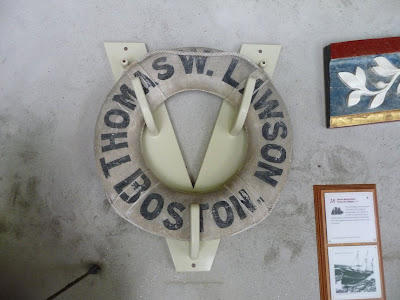 The picture above is the figure head of an old sailing ship. I don't know much about her except one thing - while she survives her ship was lost.
The picture above is the figure head of an old sailing ship. I don't know much about her except one thing - while she survives her ship was lost.For this figure head and many others can be found in a corner of the Tresco Abbey Gardens called Valhalla after the old Norse mythical hall for slain warriors. In it are mementos of some of the many, many boats that have foundered off the Isles of Scilly.
Some of the wrecks that were lost in these treacherous waters can be found in this Wikipedia article. While there will have others that have been forgotten in years gone by, the list includes some wrecks of historical note.
One such was the loss of Admiral Sir Clowdisley Shovell's fleet on the 22nd October, 1707. As graphically re-told in Dava Sobel's Longitude, the Admiral had been warned of the danger by an unnamed seaman. Unfortunately for all Admiral Shovell rather than taking the man's advice had him hung for mutiny on the spot.
Sir Clowdisley nearly made it to safety, being one of just two washed ashore. But it really wasn't to be his day, as he was found and drowned by a local woman who took a fancy to his emerald ring.
From this disaster the Board of Longitude was formed, to solve once and for the tricky question of calculating the other coordinate in addition to Latitude that is required to fix the position of a boat.
With so many wrecks there are many possible stories to tell, but in this post will give just one more, the loss of the greatest ever pure sailing ship.
The Thomas W Lawson was a seven masted steel hulled schooner built in 1902 and was powered purely by the wind, having no auxiliary engine. While there were other sailing ships that were larger, they all had an engine.
Alas the Thomas W Lawson only sailed the seas for five years as it was wrecked on the Isles of Scilly in 1907. Amongst the relics in Valhalla on the island of Tresco is this, one of its lifebelts. The seas were so rough and rocks so perilous that even some of the sailors with them drowned.

6 comments:
I am reminded of the American destroyer fleet that, rather than relying upon independent navigation, just played follow-the-leader, crashing into shoals that the lead boat's navigation had failed to avoid, near Santa Barbara, California, in the early 20th century.
It's amazing that humans don't seem to learn from the mistakes of earlier eras.
I just finished re-reading Fast Force 10, the account of the race 30 years ago where 15 died. The RNLI Station played a major role in the saving many lives and helping many of the boats in distress get to safety
Fastnet Force 10 is a very good read - just posted on it.
I do sometimes while out try to imagine what it must have been like sailing in the days when there was no GPS, no depth gauge.
During the recent Greek sailing I thought of the ancients crossing those waters, keeping to known waters and day light because of the very real difficulty of navigation when so little is known.
I wonder what they would have made of GPS, satellite phones, and live weather satellite pictures?
I was always annoyed when reading Greek drama when the gods dropped in to screw things up -- or, once in a while, to help somebody they liked.
Today, the deus ex machina has been replaced by "There's an app for that" -- the current advertising slogan, at least in the U.S., for the iPhone.
I had to laugh at one of the most recent commercials: "What if you're in Paris, and you want a personalized tour? There's an app for that." Well, I guess I've got one for London.
iPhone apps are brilliant - have just downloaded another that might post on soon.
The app to give status of trains and tube in London is absolutely invaluable, and a reason in its own right to get the iPhone.
Couldn't resist -- if so many ships have come to grief on the Isles of Scilly, how many more must have sunk amidst the Serious Isles?
Post a Comment